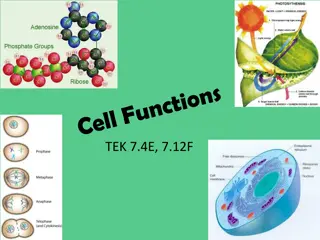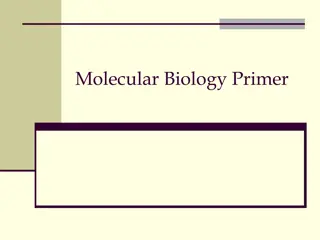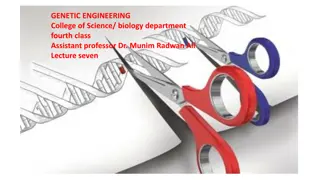Exploring Cellular Biology: From Cells to DNA
Delve into the intricacies of cellular biology by comparing prokaryotic and eukaryotic cells, investigating cellular processes, understanding viral structures and reproduction, exploring the cell cycle stages, examining specialized cells, and recognizing the crucial roles of DNA and RNA in cell differentiation and diseases like cancer.
Download Presentation

Please find below an Image/Link to download the presentation.
The content on the website is provided AS IS for your information and personal use only. It may not be sold, licensed, or shared on other websites without obtaining consent from the author. Download presentation by click this link. If you encounter any issues during the download, it is possible that the publisher has removed the file from their server.
E N D
Presentation Transcript
compare and contrast prokaryotic and eukaryotic cells.[BIO.4A] October 2014 Secondary Science - Biology
investigate and explain cellular processes, including homeostasis, energy conversions, transport of molecules, and synthesis of new molecules.[BIO.4B] October 2014 Secondary Science - Biology
compare the structures of viruses to cells, describe viral reproduction, and describe the role of viruses in causing diseases such as human immunodeficiency virus (HIV) and influenza.[BIO.4C] October 2014 Secondary Science - Biology
describe the stages of the cell cycle, including deoxyribonucleic acid (DNA) replication and mitosis, and the importance of the cell cycle to the growth of organisms.[BIO.5A] October 2014 Secondary Science - Biology
examine specialized cells, including roots, stems, and leaves of plants; and animal cells such as blood, muscle, and epithelium.[BIO.5B] October 2014 Secondary Science - Biology
describe the roles of DNA, ribonucleic acid (RNA), and environmental factors in cell differentiation.[BIO.5C] October 2014 Secondary Science - Biology
recognize that disruptions of the cell cycle lead to diseases such as cancer.[BIO.5D] October 2014 Secondary Science - Biology
identify components of DNA, and describe how information for specifying the traits of an organism is carried in the DNA.[BIO.6A] October 2014 Secondary Science - Biology
recognize that components that make up the genetic code are common to all organisms.[BIO.6B] October 2014 Secondary Science - Biology
explain the purpose and process of transcription and translation using models of DNA and RNA.[BIO.6C] October 2014 Secondary Science - Biology
recognize that gene expression is a regulated process.[BIO.6D] October 2014 Secondary Science - Biology
identify and illustrate changes in DNA and evaluate the significance of these changes.[BIO.6E] October 2014 Secondary Science - Biology
predict possible outcomes of various genetic combinations such as monohybrid crosses, dihybrid crosses and non- Mendelian inheritance.[BIO.6F] October 2014 Secondary Science - Biology
recognize the significance of meiosis to sexual reproduction.[BIO.6G] October 2014 Secondary Science - Biology
describe how techniques such as DNA fingerprinting, genetic modifications, and chromosomal analysis are used to study the genomes of organisms.[BIO.6H] October 2014 Secondary Science - Biology
analyze and evaluate how evidence of common ancestry among groups is provided by the fossil record, biogeography, and homologies, including anatomical, molecular, and developmental.[BIO.7A] October 2014 Secondary Science - Biology
analyze and evaluate scientific explanations concerning any data of sudden appearance, stasis, and sequential nature of groups in the fossil record.[BIO.7B] October 2014 Secondary Science - Biology
analyze and evaluate how natural selection produces change in populations, not individuals.[BIO.7C] October 2014 Secondary Science - Biology
analyze and evaluate how the elements of natural selection, including inherited variation, the potential of a population to produce more offspring than can survive, and a finite supply of environmental resources, result in differential reproductive success.[BIO.7D] October 2014 Secondary Science - Biology
analyze and evaluate the relationship of natural selection to adaptation and to the development of diversity in and among species.[BIO.7E] October 2014 Secondary Science - Biology
analyze and evaluate the effects of other evolutionary mechanisms, including genetic drift, gene flow, mutation, and recombination.[BIO.7F] October 2014 Secondary Science - Biology
analyze and evaluate scientific explanations concerning the complexity of the cell.[BIO.7G] October 2014 Secondary Science - Biology
define taxonomy and recognize the importance of a standardized taxonomic system to the scientific community.[BIO.8A] October 2014 Secondary Science - Biology
categorize organisms using a hierarchical classification system based on similarities and differences shared among groups.[BIO.8B] October 2014 Secondary Science - Biology
compare characteristics of taxonomic groups, including archaea, bacteria, protists, fungi, plants, and animals.[BIO.8C] October 2014 Secondary Science - Biology
compare the structures and functions of different types of biomolecules, including carbohydrates, lipids, proteins, and nucleic acids.[BIO.9A] October 2014 Secondary Science - Biology
compare the reactants and products of photosynthesis and cellular respiration in terms of energy and matter.[BIO.9B] October 2014 Secondary Science - Biology
identify and investigate the role of enzymes.[BIO.9C] October 2014 Secondary Science - Biology
analyze and evaluate the evidence regarding formation of simple organic molecules and their organization into long complex molecules having information such as the DNA molecule for self- replicating life.[BIO.9D] October 2014 Secondary Science - Biology
describe the interactions that occur among systems that perform the functions of regulation, nutrient absorption, reproduction, and defense from injury or illness in animals.[BIO.10A] October 2014 Secondary Science - Biology
describe the interactions that occur among systems that perform the functions of transport, reproduction, and response in plants.[BIO.10B] October 2014 Secondary Science - Biology
analyze the levels of organization in biological systems and relate the levels to each other and to the whole system.[BIO.10C] October 2014 Secondary Science - Biology
describe the role of internal feedback mechanisms in the maintenance of homeostasis.[BIO.11A] October 2014 Secondary Science - Biology
investigate and analyze how organisms, populations, and communities respond to external factors.[BIO.11B] October 2014 Secondary Science - Biology
summarize the role of microorganisms in both maintaining and disrupting the health of both organisms and ecosystems.[BIO.11C] October 2014 Secondary Science - Biology
describe how events and processes that occur during ecological succession can change populations and species diversity.[BIO.11D] October 2014 Secondary Science - Biology
interpret relationships, including predation, parasitism, commensalism, mutualism, and competition among organisms.[BIO.12A] October 2014 Secondary Science - Biology
compare variations and adaptations of organisms in different ecosystems.[BIO.12B] October 2014 Secondary Science - Biology
analyze the flow of matter and energy through trophic levels using various models, including food chains, food webs, and ecological pyramids.[BIO.12C] October 2014 Secondary Science - Biology
recognize that long-term survival of species is dependent on changing resource bases that are limited.[BIO.12D] October 2014 Secondary Science - Biology
describe the flow of matter through the carbon and nitrogen cycles and explain the consequences of disrupting these cycles.[BIO.12E] October 2014 Secondary Science - Biology
describe how environmental change can impact ecosystem stability.[BIO.12F] October 2014 Secondary Science - Biology























